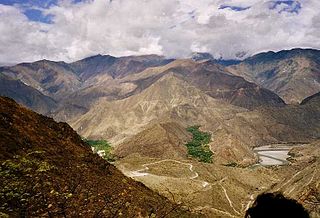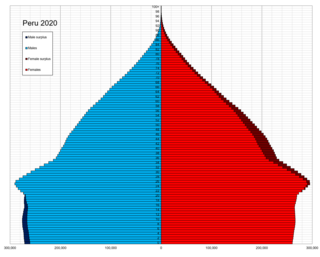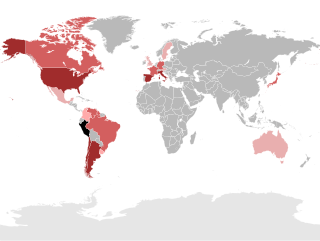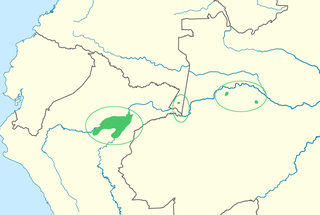Related Research Articles

The Marañón River is the principal or mainstem source of the Amazon River, arising about 160 km to the northeast of Lima, Peru, and flowing through a deeply eroded Andean valley in a northwesterly direction, along the eastern base of the Cordillera of the Andes, as far as 5° 36′ southern latitude; from where it makes a great bend to the northeast, and cuts through the jungle Andes, until at the Pongo de Manseriche it flows into the flat Amazon basin. Although historically, the term "Marañon River" often was applied to the river all the way to the Atlantic Ocean, nowadays the Marañon River is generally thought to end at the confluence with the Ucayali River, after which most cartographers label the ensuing waterway the Amazon River.

This is a demography of the population of Peru including population density, ethnicity, education level, the health of the populace, economic status, religious affiliations and other aspects of the population.

This article is about the demography of the population of Trinidad and Tobago including population density, ethnicity, education level, health of the populace, economic status, religious affiliations and other aspects of the population.

New Spain, officially the Viceroyalty of New Spain, or Kingdom of New Spain, was an integral territorial entity of the Spanish Empire, established by Habsburg Spain during the Spanish conquest of the Americas and having its capital in Mexico City. Its jurisdiction comprised a large area of the southern and western portions of North America, mainly what is now Mexico and the Southwestern United States, but also California, Florida and Louisiana; Central America, the Caribbean, and northern parts of South America; several Pacific archipelagos, most notably the Philippines and Guam; and numerous Asian port cities including Nagasaki and Spanish Formosa.

Mestizo is a person of mixed European and indigenous non-European ancestry in the Spanish Empire. In certain regions such as Latin America, it may also refer to people who are culturally European even though their ancestors are indigenous. The term was used as an ethno-racial exonym for mixed-race castas that evolved during the Spanish Empire. It was a formal label for individuals in official documents, such as censuses, parish registers, Inquisition trials, and others. Priests and royal officials might have classified persons as mestizos, but individuals also used the term in self-identification.
Omagua is a Tupí-Guarani language closely related to Cocama, belonging to the Group III subgroup of the Tupí-Guaraní family, according to Aryon Rodrigues' classification of the family. Alternate names for Omagua include: Agua, Anapia, Ariana, Cambeba, Cambeeba, Cambela, Campeba, Canga-Peba, Compeva, Janbeba, Kambeba, Macanipa, Omagua-Yete, Pariana, Umaua, Yhuata.

Amazonas is a department of Southern Colombia in the south of the country. It is the largest department in area while also having the 3rd smallest population. Its capital is Leticia and its name comes from the Amazon River, which drains the department.

The Kalapuya are a Native American people, which had eight independent groups speaking three mutually intelligible dialects. The Kalapuya tribes' traditional homelands were the Willamette Valley of present-day western Oregon in the United States, an area bounded by the Cascade Range to the east, the Oregon Coast Range at the west, the Columbia River at the north, to the Calapooya Mountains of the Umpqua River at the south.

The zebra oto or tiger oto is a fish of the genus Otocinclus of the family Loricariidae that originates from Peru.

The Huallaga River is a tributary of the Marañón River, part of the Amazon Basin. Old names for this river include Guallaga and Rio de los Motilones. The Huallaga is born on the slopes of the Andes in central Peru and joins the Marañón before the latter reaches the Ucayali River to form the Amazon. Its main affluents are the Monzón, Mayo, Biabo, Abiseo and Tocache rivers. Coca is grown in most of those valleys, which are also exposed to periodic floods.

The Indigenous peoples of the Americas are the peoples that inhabited the Americas before the arrival of European settlers in the 15th century, and the ethnic groups who now identify themselves with those peoples.

The Urarina are an indigenous people of the Peruvian Amazon Basin (Loreto) who inhabit the valleys of the Chambira, Urituyacu, and Corrientes Rivers. According to both archaeological and historical sources, they have resided in the Chambira Basin of contemporary northeastern Peru for centuries. The Urarina refer to themselves as Kachá, while ethnologists know them by the ethnonym Urarina.

The Ajuran Sultanate, also natively referred to as Ajuuraan, and often simply Ajuran, was a Somali Empire in the Middle Ages in the Horn of Africa that dominated the trade in the northern Indian ocean. They belonged to the Somali Muslim sultanate that ruled over large parts of the Horn of Africa in the Middle Ages. Through a strong centralized administration and an aggressive military stance towards invaders, the Ajuran Empire successfully resisted an Oromo incursion from the west and a Portuguese incursion from the east during the Gaal Madow and the Ajuran-Portuguese wars. Trading routes dating from the ancient and early medieval periods of Somali maritime enterprise were strengthened or re-established, and foreign trade and commerce in the coastal provinces flourished with ships sailing to and coming from many kingdoms and empires in East Asia, South Asia, Europe, the Near East, North Africa and East Africa.

The Indigenous peoples of Peru, or Native Peruvians, comprise a large number of ethnic groups who inhabit territory in present-day Peru. Indigenous cultures developed here for thousands of years before the arrival of the Spanish in 1532.

Peruvians are the citizens of Peru. What is now Peru has been inhabited for several millennia by cultures such as the Caral before the Spanish conquest in the 16th century. Peruvian population decreased from an estimated 5–9 million in the 1520s to around 600,000 in 1620 mainly because of infectious diseases carried by the Spanish. Spaniards and Africans arrived in large numbers in 1532 under colonial rule, mixing widely with each other and with Native Peruvians. During the Republic, there has been a gradual immigration of European people. Chinese and Japanese arrived in large numbers at the end of the 19th century.

Cocama (Kokáma) is a language spoken by thousands of people in western South America. It is spoken along the banks of the Northeastern lower Ucayali, lower Marañón, and Huallaga rivers and in neighboring areas of Brazil and an isolated area in Colombia. There are three dialects. The robust dialect is known as Cocama, Kokama, Kukama-Kukamiria, Ucayali, Xibitaoan, Huallaga, Pampadeque, and Pandequebo. By 1999, Cocamilla (Kokamíya) was moribund, being only spoken by people over 40.

The Spanish missions in the Americas were Catholic missions established by the Spanish Empire during the 16th to 19th centuries in the period of the Spanish colonization of the Americas. Many hundreds of missions, durable and ephemeral, created by numerous Catholic religious orders were scattered throughout the entirety of the Spanish colonies, which extended southward from the United States and Mexico to Argentina and Chile.

The Pre-Columbian period in Venezuela refers to the period before the Spanish colonization of the Americas in the 16th century, known as the Pre-Columbian era. It covers the history of what are now known as the indigenous peoples of Venezuela.

The Port of Gibraltar, also known as Gibraltar Harbour, is a seaport in the British Overseas Territory of Gibraltar. It was a strategically important location during the Napoleonic Wars and after 1869 served as a supply point for ships travelling to India through the Suez Canal. The harbour of Gibraltar was transformed in the nineteenth century as part of the British Government's policy of enabling the Royal Navy to defeat its next two largest rival navies combined. Both Gibraltar and Malta were to be made torpedo proof, and as a result the North and South Mole were extended and the Detached Mole was constructed. Three large dry docks were constructed and plans were available by 1894. Over 2,000 men were required and had to be billeted in old ships which had not been required since convict labour was abandoned. The demand for stone and sand necessitated building the Admiralty Tunnel right through the Rock of Gibraltar.
The spread of Islam spans almost 1,400 years. The early Muslim conquests that occurred following the death of Muhammad in 632 CE led to the creation of the caliphates, occupying a vast geographical area; conversion to Islam was boosted by Arab Muslim forces conquering vast territories and building imperial structures over time. Most of the significant expansion occurred during the reign of the rāshidūn ("rightly-guided") caliphs from 632 to 661 CE, which were the first four successors of Muhammad. These early caliphates, coupled with Muslim economics and trading, the Islamic Golden Age, and the age of the Islamic gunpowder empires, resulted in Islam's spread outwards from Mecca towards the Indian, Atlantic, and Pacific Oceans and the creation of the Muslim world. The Islamic conquests, which culminated in the Arab empire being established across three continents, enriched the Muslim world, achieving the economic preconditions for the emergence of this institution owing to the emphasis attached to Islamic teachings. Trade played an important role in the spread of Islam in some parts of the world, such as Indonesia.